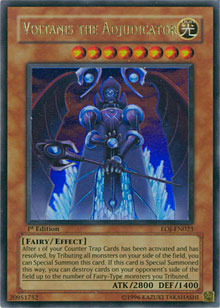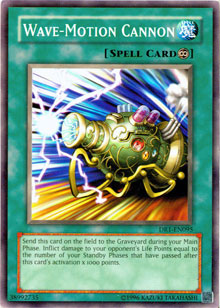
After a two-week hiatus, I cannot begin to describe how happy I am to return to my regularly scheduled column. I’m sure some of you might be happy too, seeing as how I left the segment on the Counter-Fairies completely unresolved. That’s kind of like giving you a glimpse of a brand new red sports car that you’ve been wanting, and then slamming the car door on your fingers as you run up to see what it’s like inside. My apologies for that, but today we’re back on track.
 While the previous two articles discussed the elements of card draw necessary for the control deck, today’s card is geared as the finisher for the deck. Voltanis the Adjudicator is the primary path to victory for the Counter-Control deck (While you can win through other means, you are effectively playing until you can wrap up the duel with Voltanis’s effects).
While the previous two articles discussed the elements of card draw necessary for the control deck, today’s card is geared as the finisher for the deck. Voltanis the Adjudicator is the primary path to victory for the Counter-Control deck (While you can win through other means, you are effectively playing until you can wrap up the duel with Voltanis’s effects).
What exactly makes a card a good finisher for a control deck? What qualities does Voltanis the Adjudicator possess that fill this role for Counter-Control? A control deck must be able to win the game quickly and efficiently in a matter of one or two turns for it to truly work. There are quite a few examples of what cards qualify as finishers.
The Goat Control deck last year was a heavy late-game deck, and it provides a good example of a path to victory. Black Luster Soldier - Envoy of the Beginning often won the game the moment it hit the field, making it the perfect card for a deck that already mixed Light and Dark attribute monsters well enough. However, if that card wasn’t around, Cybernetic Magician would have been the next best option. Its effect allows you to instantaneously rush your opponent for a lot of damage in one turn thanks to the deck’s ability to keep Sheep tokens on the field. With tricks such as looping Night Assailant, the Cybernetic Magician acted as a solid finisher that wins the game the moment it hits the field, as long as it was played when the Goat Control’s game was stabilized in its favor.
The Return-Chaos deck of today is another good example of a control deck that utilizes a late-game path to victory. While the deck can be very fast if its user’s draws are stellar, the Return-Chaos deck still commonly plays for a late game. Return from the Different Dimension acts as the deck’s finisher. When you activate it, your opponent usually scoops up his or her cards in defeat. While Zaborg the Thunder Monarch can push in an occasional direct attack, it is unusual for the player to put in that extra effort just for 2400 damage.
 Another strong example of a good path to victory for a control deck is Wave-Motion Cannon. For decks that keep the opponent from attacking, such as the control-stasis decks based on Des Lacooda, the Wave-Motion Cannon fulfills an important role. It is one of the cards in your deck that can win you the game without requiring you to enter your battle phase. However, it is also a lightning rod for your opponent’s targeted spell and trap removal. In the early game, the Wave-Motion Cannon will probably just protect your stall devices, getting you into the late game when additional Wave-Motion Cannon cards act as the path to victory. This card is actually perfect for the Counter-Control deck, since you technically want to see as little action as possible early in a duel.
Another strong example of a good path to victory for a control deck is Wave-Motion Cannon. For decks that keep the opponent from attacking, such as the control-stasis decks based on Des Lacooda, the Wave-Motion Cannon fulfills an important role. It is one of the cards in your deck that can win you the game without requiring you to enter your battle phase. However, it is also a lightning rod for your opponent’s targeted spell and trap removal. In the early game, the Wave-Motion Cannon will probably just protect your stall devices, getting you into the late game when additional Wave-Motion Cannon cards act as the path to victory. This card is actually perfect for the Counter-Control deck, since you technically want to see as little action as possible early in a duel.
Oh, right! This article was supposed to be about Voltanis the Adjudicator, wasn’t it?
So how exactly does Voltanis compare to previous control deck paths to victory? It’s not a powerful trap like Return from the Different Dimension, nor is it a spell card that can win you the game single-handedly. However, as a monster, it can guarantee you a win for the duel. The effect of Voltanis the Adjudicator is powerful and extremely versatile. Monsters that can be summoned during your opponent’s turn can easily surprise your opponent, and Voltanis the Adjudicator is no exception.
Counter-Control decks will typically have a couple of Fairies on the field, and usually those Fairies will not be able to punch through many monsters in order to win you the duel. This is where Voltanis comes into play (literally). Activating a counter-trap will not only give you the benefits of Bountiful Artemis, it also allows you to summon Voltanis the Adjudicator. Once Voltanis arrives, you will be able to destroy cards on your opponent’s field equal to the number of Fairies you tributed for its special summon. Mass destruction is incredible, and it is even more important when Voltanis the Adjudicator is clearing a path to your opponent’s life points.
There are two major benefits to the destruction effect of Voltanis the Adjudicator. The first is that you can destroy any cards. This means that monsters, spells, and traps are all vulnerable to your finisher. The second, and probably most beneficial ability, is that you destroy cards on your opponent’s field at resolution. Your opponent can still chain a Bottomless Trap Hole to deal with your finisher, but that doesn’t mean you can’t destroy your opponent’s field anyway. Since you don’t target anything, your opponent cannot minimize the damage that will be dealt to his or her field, meaning that you will be able to deal with many of your opponent’s current options. Even if Voltanis the Adjudicator is dealt with immediately, its effect will still clear a path for your other monsters to attack your opponent directly. Your opponent will also be low on options— with many of his or her cards destroyed—so his or her chances of resolving any key cards will probably be smashed by your counter-traps.
While the effect of Voltanis would usually only clear away two cards at most, Power of the Duelist brought in a new support card for the Counter-Control deck. Synthetic Seraphim is an incredible boost to the counter-trap strategy, since it can provide you with plenty of tokens as the game progresses. While the tokens don’t do much, they are free whenever you activate a counter-trap, and can do a good job of defending your life points from an opponent’s onslaught. More importantly, those tokens are Fairies. Last time I checked, Voltanis the Adjudicator, your deck’s path to victory, likes seeing Fairies on your field. This turns Synthetic Seraphim into a solid defensive wall and a tool for generating one serious, field-busting Voltanis the Adjudicator.
With the three key monsters in the Counter-Control deck featured, it is time to look into the different strategies available to complete a variation of this archetype. Check in next week for some sample decklists, as well as tips on how to play the deck.
If you have any questions or comments, feel free to e-mail me at Mrosenberg at Metagame dot Com.